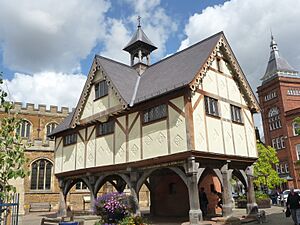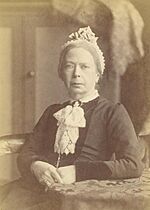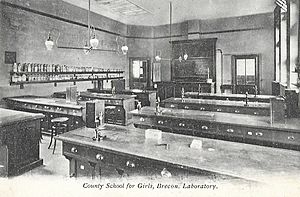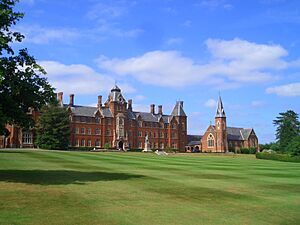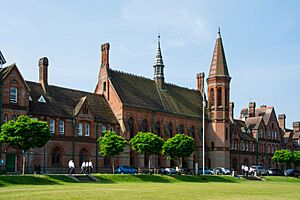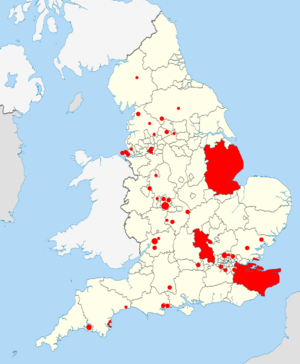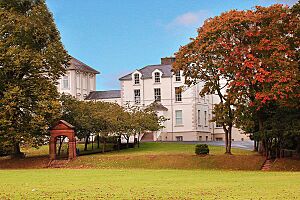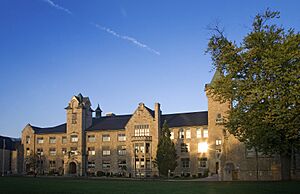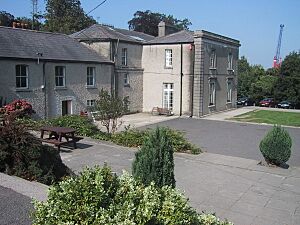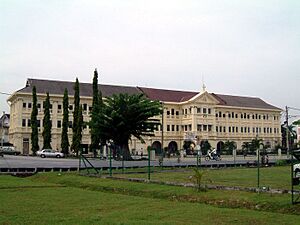Grammar school facts for kids
A grammar school is a type of school that has a long history in the United Kingdom and other countries where English is spoken. Originally, these schools taught mostly Latin, but over time, they became special secondary schools that focused on academic subjects and selected students based on their academic ability.
In the past, grammar schools mainly taught Latin to students. Later, they added other subjects like Ancient Greek, English, other European languages, natural sciences, mathematics, history, geography, art, and more. In the late 1800s, grammar schools in England and Wales were reorganized to provide secondary education. Similar schools were also set up in British territories around the world, and they developed in different ways.
From the 1940s to the 1960s, grammar schools were part of a three-part system of state-funded secondary education in England and Wales, and they still exist in Northern Ireland. When many local areas switched to non-selective comprehensive schools in the 1960s and 1970s, some grammar schools became private schools that charged fees. Others were closed or became comprehensive schools. Some schools kept "grammar school" in their name even if they changed. More recently, some state grammar schools, which still select students, became academies, meaning they are independent from local education authorities. A few areas still have grammar schools, and some of these schools have histories going back before the 1400s.
Contents
History of Grammar Schools
Early Schools: Medieval Times
Even though the name "grammar schools" became common in the 1300s, the first schools like these appeared much earlier, around the 500s. Examples include the King's School, Canterbury (started in 597) and St Peter's School, York (started in 627).
These schools were usually connected to cathedrals and monasteries. They taught Latin, which was the language of the church, to young people who wanted to become priests or monks. Sometimes, they also taught music, poetry, astronomy, mathematics, and law, which were useful for church work.
When the first universities started in the late 1100s, grammar schools became the place where students prepared for a liberal arts education. Latin was seen as the basic subject. Students usually stayed in grammar schools until they were about 14. After that, they would go to universities or join the church for more studies. Some of the first schools that were not directly controlled by the church, like Winchester College (1382) and Eton College (1440), prepared students for Oxford and Cambridge universities. These were boarding schools, so students from all over the country could attend.
Changes in Early Modern Times
An early grammar school not connected to the church or a university was Bridgnorth Grammar School, founded in 1503.
During the English Reformation in the 1500s, many church schools closed. New schools were then started using money from the closing of monasteries. For example, the oldest schools in Wales, Christ College, Brecon (1541) and the Friars School, Bangor (1557), were built where monasteries used to be. King Edward VI helped grammar schools a lot by starting many new ones. Some were also founded in the names of Queen Mary and Queen Elizabeth I. King James I started "Royal Schools" in Ulster. In theory, these schools were open to everyone and offered free teaching to those who couldn't pay. However, not many poor children went because their families needed them to work.
In Scotland, schools like the High School of Glasgow (1124) and the Grammar School of the Church of Edinburgh (1128) moved from church control to city councils. The cities also started new schools. After the Reformation, there was more focus on studying religious texts, so many schools added Greek and sometimes Hebrew.
In the 1500s and 1600s, rich people and groups often started grammar schools as a way to help their communities. For example, The Crypt School, Gloucester, was founded in 1539. These schools usually had money set aside to pay a teacher to teach local boys Latin and sometimes Greek for free. Many schools still remember their founders with special "Founder's Day" events.
A typical school day was very long, from 6 a.m. to 5 p.m., with a two-hour lunch break. In winter, it was from 7 a.m. to 4 p.m. Most of the day was spent memorizing Latin. To make sure students spoke Latin, some teachers even punished those who spoke English. Younger boys learned Latin words and grammar, then how to build sentences, and finally translated between English and Latin. By age 14, they knew a lot about famous Latin writers and plays. Other skills like arithmetic and handwriting were taught quickly or by special visiting teachers.
Grammar Schools in the 1700s and 1800s
In 1755, Samuel Johnson's dictionary said a grammar school was "a school in which the learned languages are grammatically taught." But by this time, fewer people wanted to learn Latin and Greek. A new group of business people needed modern languages and business subjects. Most grammar schools started in the 1700s also taught arithmetic and English. In Scotland, city councils changed their school subjects, so Scotland no longer has grammar schools in the same way, though some schools like Aberdeen Grammar School still have the name.
In England, middle-class families in cities wanted schools to teach business subjects. School leaders often agreed to this and charged fees for new students. However, the original rules of the schools often said they had to teach classical languages, and teachers sometimes resisted changes. A famous legal case about Leeds Grammar School in 1805 decided that schools could not completely change from teaching Greek and Latin to teaching German, French, and mathematics. This ruling made it hard for grammar schools to change, and many seemed to be struggling. However, some grammar schools in the north-west of England and South Wales actually provided higher education for young men who wanted to become Anglican clergymen without going to university.
Victorian Era Grammar Schools
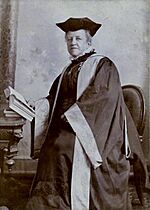
The 1800s brought many changes to grammar schools, especially with the Endowed Schools Act 1869. Grammar schools were remade into academic secondary schools that taught a mix of literature, science, and often still classical subjects.
The Grammar Schools Act 1840 allowed schools to use their money for things other than just classical languages, but they needed court approval. In the mid-1800s, some schools started to reorganize themselves like Rugby School. Also, the spread of railways helped new boarding schools, like Marlborough College (1843), become successful by offering a wider range of subjects.
The first schools for girls that aimed for university entrance were North London Collegiate School (1850) and Cheltenham Ladies' College (from 1858). More academic girls' secondary schools were created later in the 1800s. In places where there was already an older boys' grammar school, the girls' school was often called a "high school," like Manchester High School for Girls (1874).
A government commission in 1868 looked at 782 grammar schools. It found that schools were not located where most people lived, and the quality of education varied a lot, especially for girls. The commission suggested creating a national system of secondary education by changing how these schools used their money. This led to the Endowed Schools Act 1869, which gave a special commission a lot of power over school funds. Schools that were set up to offer free classical teaching to boys were changed into fee-paying schools (with some scholarships) that taught many subjects to boys or girls.
In the late 1800s, there was a big focus on self-improvement. Many schools started then copied the famous public schools, using their subjects, values, and goals. Some kept the name "grammar school" for historical reasons.
In 1907, a new rule offered more money to secondary schools that gave at least 25% of their places as free scholarships to students from public elementary schools. This helped grammar schools become an important part of the education system in England and Wales before 1944.
The Tripartite System
The Education Act 1944 created the first nationwide system of state-funded secondary education in England and Wales, with a similar law in Northern Ireland in 1947. One of the three types of schools in this system was the grammar school. These schools aimed to provide an academic education to the top 25% of students, who were chosen based on an exam called the 11-plus.
There were two main types of grammar schools:
- State-maintained grammar schools: These were fully funded by the government. In 1964, there were 1,298 of them in England and Wales. Many were new or built after the Victorian period, trying to create a serious, ambitious atmosphere like the older grammar schools.
- Direct-grant grammar schools: There were 179 of these. They took between a quarter and half of their students from the state system, and the rest were fee-paying. They had more freedom from local authorities. Some of these were very old schools that joined the system. A famous example was Manchester Grammar School.
Grammar school students had the best opportunities in the state system. They took exams like the General Certificate of Education at O-level and A-level. In contrast, very few students at secondary modern schools took these exams until the less academic Certificate of Secondary Education (CSE) was introduced in 1965. Until the 1960s, students from public schools and grammar schools mostly filled the places at universities. These schools were also the only ones that prepared students for the tough entrance exams for Oxford and Cambridge.
However, there were problems with the 11-plus exam. It often meant that secondary modern schools were mostly filled with children from poor and working-class families, while grammar schools had more children from wealthier middle-class families. The Tripartite System was mostly ended in England and Wales between 1965 and 1976. Most state-funded grammar schools were combined with other local schools to form neighborhood comprehensive schools, or some were closed. This happened quickly in Wales. In England, it was slower, and some areas and schools managed to avoid changing or closing.
In 1975, direct-grant grammar schools had to choose whether to become comprehensive schools under local control or become private schools funded entirely by fees. Of those remaining, 51 became comprehensive, 119 became independent, and five either became independent or closed. Some of these schools kept "grammar" in their name but are no longer free for most students. These schools usually select students through an entrance exam and sometimes an interview.
By the end of the 1980s, almost all grammar schools in Wales and most in England had closed or become comprehensive. Student selection also ended in state-funded schools in Scotland. Although most former grammar schools stopped being selective, some comprehensive schools chose to keep "grammar" in their name. Many of these schools do have some form of selection because they have more applicants than places. There are also a few partially selective schools that choose some students based on academic ability. The old system (grammar and secondary modern schools) still exists in some areas, like Kent, where the 11-plus exam is called the Kent Test.
Current British Grammar Schools
Today, a grammar school usually means one of the 163 remaining fully selective state-funded schools in England and the 69 remaining in Northern Ireland. Groups like the National Grammar Schools Association support these schools, while others like Comprehensive Future are against them. A study by University College London found that grammar school students in the UK don't gain significant social or emotional benefits by age 14 compared to equally smart students in non-selective schools.
Grammar Schools in England
England has a long history of grammar schools. The subjects taught can vary, but generally include English, mathematics, computer science, physics, chemistry, biology, geography, art, music, drama, design and technology, history, philosophy, civics/citizenship, classical education, religious education, physical education, and several foreign languages. Most English grammar schools follow the National Curriculum and use the same national exams as other state schools.
Under a law passed in 1998, local communities could ask for a vote to end selection at grammar schools. Petitions were started in several areas, but only one, for Ripon Grammar School in 2000, got enough signatures to trigger a vote. Parents there voted 2 to 1 against changing the school. These rules were later criticized as being ineffective.
There are 163 grammar schools left in England (out of about 3,000 state secondary schools). Only a few areas still have a formal grammar school system like the old Tripartite System. In these areas, the eleven plus exam is used only to find about 25% of children who are thought to be suitable for grammar school. If a grammar school has too many qualified applicants, other things like having siblings at the school, living close by, or faith might be used to decide who gets a place. Such systems still exist in Buckinghamshire, parts of Warwickshire, Wiltshire, most of Lincolnshire, Kent, Reading, and Medway. In cities, Trafford and most of Wirral have selective schools.
In other areas, grammar schools are very highly selective schools in counties that are otherwise comprehensive. For example, in some outer parts of London. These schools often have many more applicants than places and choose students based on their scores in entry tests. In some areas, as many as 10–15% of 11-year-olds might go to grammar schools (like in Gloucestershire), but in others, it's as low as 2%. These very selective schools also tend to be at the top of performance tables.
Besides grammar schools, some partially-selective schools also select students. These are technically comprehensive schools but are somewhere between grammar schools and true comprehensive schools.
Until September 2016, both major political parties were against expanding grammar schools. However, in September 2016, Prime Minister Theresa May changed the policy to allow existing grammar schools to expand and new ones to be set up. The Labour and Liberal Democrat parties are still against any expansion.
Grammar Schools in Northern Ireland
Attempts to switch to a comprehensive system in Northern Ireland have been delayed. As a result, Northern Ireland still has the grammar school system. Many students take academic selection exams similar to the 11-plus. Since 1989, these schools have had to accept students up to their full capacity. By 2006, the 69 grammar schools took 42% of students moving to secondary school.
The 11-plus exam has been a topic of debate for a long time. Political parties in Northern Ireland have different views. Unionists generally want to keep grammar schools and academic selection at age 11. Nationalist politicians want to get rid of the 11-plus, even though many Catholic Grammar Schools have strongly protested this, like Rathmore Grammar School and Lumen Christi.
The Democratic Unionist Party said they made sure the grammar school system would continue as part of an agreement in October 2006. On the other hand, Sinn Féin said they secured the end of the 11-plus and a way to stop any new system that might replace it.
The last government-run 11-plus exam was in 2008. However, the Northern Ireland Assembly has not agreed on a new system for students moving to secondary school. Grammar schools have organized groups to run their own tests, such as the Post-Primary Transfer Consortium (mostly Catholic schools) and the Association for Quality Education. The Northern Ireland Commission for Catholic Education agreed to continued selection at Catholic grammar schools for a while, expecting it to end by 2012. As of 2019, this practice still continues.
Grammar Schools in Other Countries
Grammar schools were started in various British territories and have changed in different ways since those places became independent.
Australia
In the mid-1800s, private schools were set up in the Australian colonies so that wealthy families didn't have to send their sons to schools in Britain. These schools were inspired by English public schools and often called themselves "grammar schools." Early examples include Launceston Grammar School (1846) and Melbourne Grammar School (1858).
Most grammar schools started in the 1800s were connected to the Anglican Church of Australia, except for the non-religious Sydney Grammar School (1857) and Queensland grammar schools. In Queensland, a law in 1860 allowed for state-supported non-religious grammar schools. Ten schools were founded, starting with Ipswich Grammar School (1863). Eight of these still exist today, including Brisbane Grammar School and Brisbane Girls Grammar School (1875), which was the first grammar school for girls in Australia.
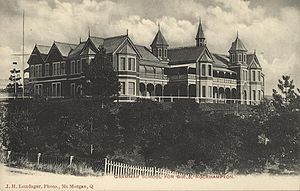
In the 1920s, grammar schools of other religious groups were started, and this trend continues. Today, in Australia, "grammar schools" are generally expensive private schools.
The closest schools to today's English grammar schools in Australia are selective schools. The public education system in New South Wales has 19 selective public schools. These schools are similar to English grammar schools because they select students based on academic tests, do not charge tuition fees, and receive more public funding per student than other government schools.
Canada
Grammar schools provided secondary education in Ontario until 1871. The first leader of Upper Canada, John Graves Simcoe, wanted grammar schools to be set up so wealthy families wouldn't send their sons to the United States for education. He helped start Kingston Grammar School in 1795. A law in 1807 provided support for one grammar school teacher in each district.
Because grammar schools weren't preparing students well enough for university, Lieutenant-Governor Sir John Colborne founded Upper Canada College as a better grammar school. A law in 1839 allowed more than one grammar school in a district, leading to a quick growth in numbers. The schools became more independent from the Church of England and started to admit girls. However, they were not well supervised, often didn't have enough money, and varied in quality. Some, like Tassie's School in Galt, offered a traditional classical education, but many provided a basic, poor-quality education.
The Chief Superintendent of Education, Egerton Ryerson, tried to improve the schools in the 1850s and 1860s by moving control from counties to city authorities, making sure they had funding, and introducing inspectors. However, his efforts to make the schools only for boys and focused on classical studies were not successful. In 1871, grammar schools were renamed "secondary schools" because they offered a wide range of subjects. Schools that offered classical studies received extra funding and were called collegiate institutes. This secondary school system was also copied in other provinces in Western Canada.
Hong Kong
Schools in Hong Kong often reflect the British grammar school system from after World War II. They focus on a traditional curriculum rather than subjects that prepare students for specific jobs.
Ireland
Education in the Republic of Ireland has traditionally been organized by religious groups. Grammar schools, similar to those in Great Britain, were set up for members of the Church of Ireland before it was no longer the official state church in 1871. Some of these schools still exist as private schools, mostly for Protestant students. They often charge fees and have boarding facilities because Protestant families are spread out across Ireland. Examples include Bandon Grammar School and Drogheda Grammar School. Other former fee-paying schools were taken over by larger state-funded community schools after universal secondary education was introduced in 1967. For example, Cork Grammar School was replaced by Ashton School in 1972.
Malaysia
Malaysia has several grammar schools, most of which were started when the country was under British rule. They are not usually called "grammar schools" but they do select their students. Some of the most well-known include the Penang Free School, the Victoria Institution (Kuala Lumpur), and the English College (Johor Bahru). Mission schools, started by different Christian groups, were similar to these selective state schools, though not as selective. Before the 1970s, when Malay became the main language of teaching, many of these selective schools were known for providing excellent English-language education. Many famous people, including former Prime Ministers of Malaysia, attended these schools.
New Zealand
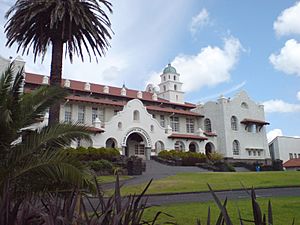
In New Zealand, a few schools are called "grammar schools" and follow the academic and cultural traditions from the United Kingdom. Grammar schools were only established in Auckland and were originally managed by the Auckland Grammar Schools' Board. Auckland's grammar schools share a common history from the British system, focusing strongly on academics and traditional British sports. Originally, these schools used entry tests and selected academic students from all over New Zealand. The schools mentioned below all share the motto: "Per Angusta Ad Augusta" (Through difficulties to honors). They also share the same lion logo. Today, all grammar schools in New Zealand are non-selective state schools, but they ask for donations to help with their funding. The Ministry of Education sees them as any other secondary school.
New Zealand did not have a state education system until 1877. Before that, grammar schools and other private schools were the main providers of secondary education. The first grammar school in New Zealand, Auckland Grammar School, was started in 1850. In 1888, Auckland Girls' Grammar School was established. In 1917, Auckland Grammar School's sister school, Epsom Girls' Grammar School, was founded. In 1922, Mount Albert Grammar School was started as part of Auckland Grammar School, but both schools are now separate. Takapuna Grammar School was established in 1927 and was the first co-educational grammar school in New Zealand.
Singapore
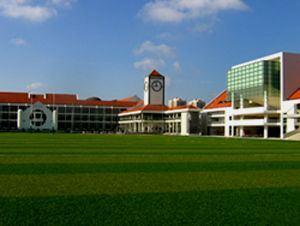
When Singapore was a British colony, the term "grammar school" was used among the English community. The English and Scottish communities set up churches and elite grammar schools for the upper class. At first, this system separated people by race.
Later, the British opened their schools to children from mixed English marriages or those with English ancestors. During the late colonial period, these schools grew and also taught children of mixed English and Straits-Chinese families, and children of some rich Straits-born Chinese merchant families who had connections to London. Initially, these schools were run exactly like those in England and taught by English teachers.
The oldest of these, Raffles Institution, was founded in 1823 by Sir Stamford Raffles to educate sons born and living in the colony. Single-sex classes for daughters of the British ruling class were set up in 1844, which later became Raffles Girls' School, officially founded in 1879. After Singapore became independent, it became the Raffles Girls' School (Primary School), separate from the branch school started by the local government, the Raffles Girls' School (Secondary School).
French Roman Catholic groups later opened their schools to children from mixed marriages, and racial separation was also relaxed in English schools. The French Catholic schools, unlike the English ones, also accepted orphans and children abandoned by mothers who broke racial purity rules. These children were raised as Catholics. When laws against polygamy were strictly enforced in Singapore after 1965, these schools extended their English-speaking classes to girls from any family background. British grammar schools in Singapore copied much of this education system, with Anglicanism instead of Catholicism. Later, the Anglican High School was set up. Australian Methodist missionaries also started UK-style grammar schools with American and British Methodist church funds. They founded the Anglo-Chinese School (1886) and Methodist Girls' School (1887).
When Singapore became independent from the United Kingdom, the Singapore government started publicly funded bilingual schools based on the existing grammar school system. Since the 1960s, their goal was to provide a high-quality elite education to the top 10% of students in national IQ tests, no matter their family background. These bilingual schools were influenced by the US education system and were called "high schools" instead of "grammar schools." Other, less elite, state schools were simply called "secondary schools," similar to comprehensive schools in the UK. High schools include Dunman High School (for boys and girls), Nanyang Girls' High School, and Catholic High School (for boys only). Within these schools, there are academically top classes. Graduates often become part of the upper class. These schools recruit students from all over the world, especially from large growing Asian economies. They look for gifted students, like winners of math or physics competitions.
Besides religious schools and the new high schools, the less selective Singapore Chinese Girls' School was started by several business and community leaders. The Ministry of Education used to publish annual school rankings but stopped after criticism that it put too much academic pressure on students. After the 1990s, all schools became part of one national school system, but the elite schools called themselves "independent" or "autonomous."
United States
Grammar schools, based on the English model, were founded in the colonial period. The first was the Boston Latin School, started in 1635. In 1647, the Massachusetts Bay Colony passed a law requiring any town with at least 100 households to set up a grammar school. Similar laws followed in other New England colonies. These schools initially taught young men classical languages to prepare them for university. However, by the mid-1700s, many had added practical subjects. Still, they became less popular because of competition from more practical academies.
The name "grammar school" was later used by public schools for children aged 10 to 14, after a primary stage for ages 5 to 9. These types of schools gradually combined around 1900 to form elementary schools, which were also known as "grammar schools."
A similar idea to today's English grammar school in the US is the magnet school. These are state-funded secondary schools that can select students from a school district based on academic ability.
See also
 In Spanish: Grammar school para niños
In Spanish: Grammar school para niños
- Grammar schools debate
- History of education in England
- Latin school
- National Grammar Schools Association
- Partially selective school (England)



